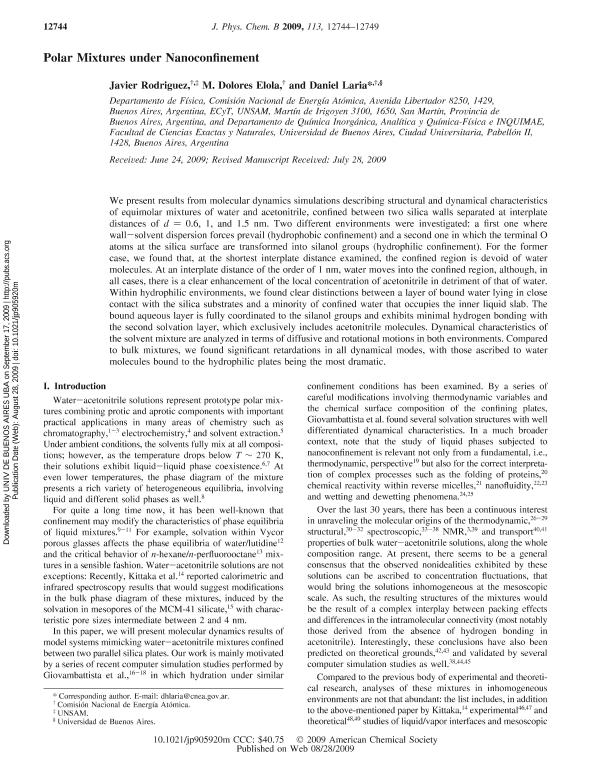Artículo
Polar mixtures under nanoconfinement
Fecha de publicación:
09/2009
Editorial:
American Chemical Society
Revista:
Journal of Physical Chemistry B
ISSN:
1089-5647
e-ISSN:
1520-6106
Idioma:
Inglés
Tipo de recurso:
Artículo publicado
Clasificación temática:
Resumen
We present results from molecular dynamics simulations describing structural and dynamical characteristics of equimolar mixtures of water and acetonitrile, confined between two silica walls separated at interplate distances of d = 0.6, 1, and 1.5 nm. Two different environments were investigated: a first one where wall-solvent dispersion forces prevail (hydrophobic confinement) and a second one in which the terminal O atoms at the silica surface are transformed into silanol groups (hydrophilic confinement). For the former case, we found that, at the shortest interplate distance examined, the confined region is devoid of water molecules. At an interplate distance of the order of 1 nm, water moves into the confined region, although, in all cases, there is a clear enhancement of the local concentration of acetonitrile in detriment of that of water. Within hydrophilic environments, we found clear distinctions between a layer of bound water lying in close contact with the silica substrates and a minority of confined water that occupies the inner liquid slab. The bound aqueous layer is fully coordinated to the silanol groups and exhibits minimal hydrogen bonding with the second solvation layer, which exclusively includes acetonitrile molecules. Dynamical characteristics of the solvent mixture are analyzed in terms of diffusive and rotational motions in both environments. Compared to bulk mixtures, we found significant retardations in all dynamical modes, with those ascribed to water molecules bound to the hydrophilic plates being the most dramatic.
Archivos asociados
Licencia
Identificadores
Colecciones
Articulos(INQUIMAE)
Articulos de INST.D/QUIM FIS D/L MATERIALES MEDIOAMB Y ENERGIA
Articulos de INST.D/QUIM FIS D/L MATERIALES MEDIOAMB Y ENERGIA
Articulos(SEDE CENTRAL)
Articulos de SEDE CENTRAL
Articulos de SEDE CENTRAL
Citación
Rodriguez, Javier; Elola, Maria Dolores; Laria, Daniel Hector; Polar mixtures under nanoconfinement; American Chemical Society; Journal of Physical Chemistry B; 113; 38; 9-2009; 12744-12749
Compartir
Altmétricas




